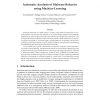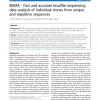335 search results - page 54 / 67 » An Architecture-Centric Approach to Detecting Security Patte... |
JCS
2011
12 years 10 months ago
2011
Malicious software—so called malware—poses a major threat to the security of computer systems. The amount and diversity of its variants render classic security defenses ineffe...
CCS
2007
ACM
14 years 1 months ago
2007
ACM
To ameliorate the quality of protection provided by intrusion detection systems (IDS) we strongly need more effective evaluation and testing procedures. Evaluating an IDS against ...
BMCBI
2010
13 years 7 months ago
2010
Background: Bisulfite sequencing is a popular method to analyze DNA methylation patterns at high resolution. A region of interest is targeted by PCR and about 20-50 subcloned DNA ...
IEEEARES
2010
IEEE
14 years 2 months ago
2010
IEEE
—Program obfuscation is often employed by malware in order to avoid detection by anti-virus software, but it has many other legitimate uses, such as copy protection, software lic...
COMPSEC
2002
13 years 7 months ago
2002
In this paper an insider attack is considered to be deliberate misuse by those who are authorized to use computers and networks. Applying this definition in real-life settings to ...


